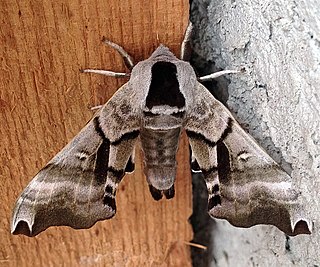
Smerinthus cerisyi, the one-eyed sphinx or Cerisy's sphinx, is a moth of the family Sphingidae. The species was first described by William Kirby who named the species in honor of Alexandre Louis Lefèbvre de Cérisy in 1837.

Xylophanes tersa, the tersa sphinx, is a moth of the family Sphingidae. The species was first described by Carl Linnaeus in 1771. It is found from the United States, through Mexico, the West Indies and Central America and into parts of South America. An occasional stray can be found as far north as Canada.
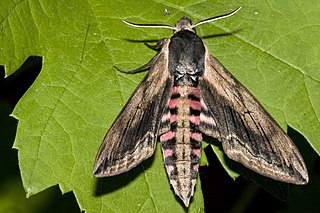
Sphinx ligustri, the privet hawk moth, is a moth found in most of the Palearctic realm. The species was first described by Carl Linnaeus in his 1758 10th edition of Systema Naturae.

Erinnyis lassauxii, or Lassaux's sphinx, is a moth of the family Sphingidae.
Pachysphinx modesta, the modest sphinx or poplar sphinx, is a moth of the family Sphingidae. The species was first described by Thaddeus William Harris in 1839.
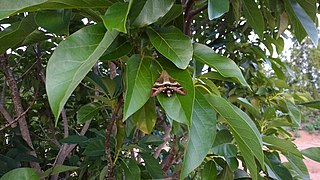
Aellopos fadus, the Fadus sphinx, is a moth of the family Sphingidae. The species was first described by Pieter Cramer in 1776.

The fabulous green sphinx moth or fabulous green sphinx of Kauai is a species of moth in the family Sphingidae. It is monotypic within the genus Tinostoma. It is endemic to the Hawaiian Islands and was thought to be extinct until it was rediscovered in 1998. The genus was erected by Walter Rothschild and Karl Jordan in 1903 and the species was first described by Edward Meyrick in 1899.

Sphinx morio, the larch hawk moth or Asian pine hawkmoth, is a moth of the family Sphingidae. It is found in Russia, the Korean Peninsula, Japan and China.

Sphinx poecila, the poecila sphinx, is a moth of the family Sphingidae. It is found from Newfoundland and Maine south to Pennsylvania and west to Michigan, northeastern Illinois and Wisconsin.

Clanis bilineata, the two-lined velvet hawkmoth, is a moth of the family Sphingidae first described by Francis Walker in 1866.
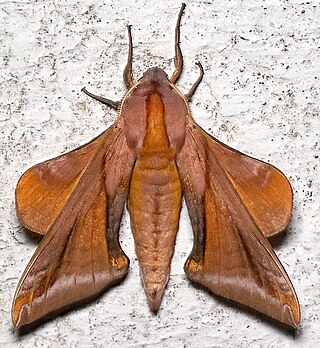
Paonias astylus, the huckleberry sphinx, is a moth in the family Sphingidae. The species was first described by Dru Drury in 1773.

Acosmeryx formosana is a moth of the family Sphingidae. It was described by Shōnen Matsumura in 1927. It is endemic to Taiwan.
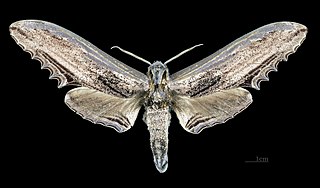
Langia zenzeroides, the apple hawkmoth, is a moth of the family Sphingidae. It was described by Frederic Moore in 1872.
Leucophlebia formosana is a moth of the family Sphingidae. It is known from China and Taiwan.

Rhagastis castor is a moth of the family Sphingidae first described by Francis Walker in 1856.
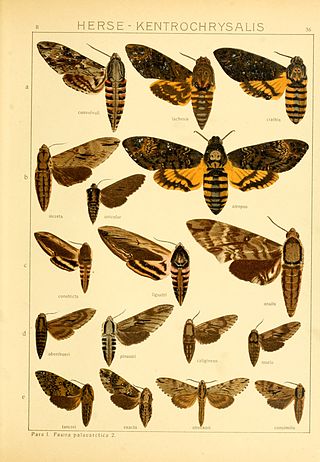
Sphinx oberthueri is a moth of the family Sphingidae. It is found from central and south-western China to northern Thailand.

Sphinx crassistriga is a moth of the family Sphingidae. It is known from Japan.
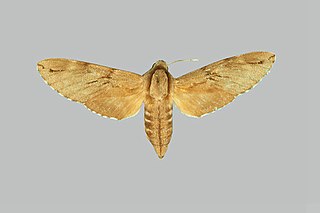
Sphinx caligineus, the Chinese pine hawkmoth, is a moth of the family Sphingidae. It is known from Japan, north-eastern, eastern, central and southern China, South Korea, northern Thailand and southern Vietnam.
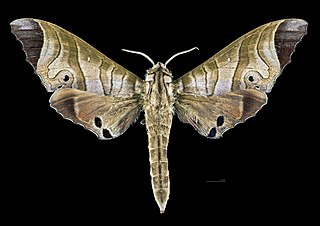
Marumba saishiuana is a species of moth of the family Sphingidae.

Pentateucha inouei, the Taiwanese hirsute hawkmoth, is a species of moth of the family Sphingidae. It is known from Taiwan. The habitat consists of alpine forests.



















